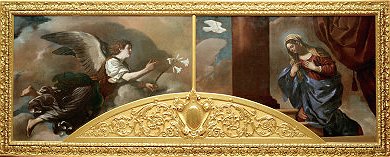He was largely self-taught. The most lovable and innovative of the Bolognese school, he died in Bologna in 1666. Guercino was one of the leading painters of the Bolognese school, and one of the most accomplished draftsmen of the Italian Baroque. His paintings show a command of subtle effects of light and dark, with the figures revealing a wide variety of gesture and facial expression, the result of the artist's good grasp of human psychology. Guercino's style changed dramatically during his long career. His early works are robust in handling, rich in muted color, and dramatic in lighting and composition. Guercino was called to Rome when his patron Gregory XV was elevated to the papacy (1621-23). At that time he was the most innovative Baroque painter in Italy – a Baroque naturalist. After that visit to Rome, his painting underwent a fundamental change as he came under the influence of a more classical style of painting, then so popular in official circles. Hallmarks of his later work are clarity of composition, refined color, delicate expression. The frescoes and paintings he executed in the Holy City were of fundamental importance in the development of high baroque art. By the time he retired to his native town of Cento in 1623, his style had been decidedly tempered by the classicism of Carraci. To a degree his development parallels that of Reni. SUBJECT: PAINTING: Because of its location and shape, the canvas posed unusual problems. The artist solved them by removing the scene from its customary interior and showing Mary kneeling on the steps of an abstract architectural setting against an expanse of sky. With only clouds as background, there is no extraneous detail to compete for your attention. Note how the shape of the clouds follows the contour of Gabriel’s wings. As the Annunciation itself came in the spring, and lilies’ season is also spring, lilies came to be the symbol for Mary’s purity. The approach is classical: Mary is idealized, the angel is seen in profile. To balance the composition, Guercino painted the angel oversized, so that his presence fills the left side of the picture. Like Leonardo before him, Guercino made effective use of the interval between the figures. The gap serves to carry the divine message from the angel to the Virgin, whose gesture reflects her reception of its import.* (see below) The color is subdued, but the clouds and draperies are high Baroque – full of movement. Immediate recognition and devotion are evoked in the viewer, and the steps provide an entryway for us. John Ringling purchased this painting at Christie’s in London July 12, 1929 - the greatest bargain of his entire collection. The present frame was created here in 1989. If one compares this with Renaissance versions, we see the same iconography, but the gestures are less formalized and it’s all done more naturalistically now. *Harking back to the 15th century – but still true in the 17th – the painter was a professional visualizer of the holy stories. At that earlier time Fra Roberto Caracciolo da Lecce, a dramatic 15th c. priest who wore armor beneath his robe to emphasize the Crusades, spoke about the painter’s responsibilities in portraying the Virgin, who was to be shown in 5 hand positions:
Additional Bibliography: Painting and Experience in 15th c Italy. Michael Baxandall, 1972
|
